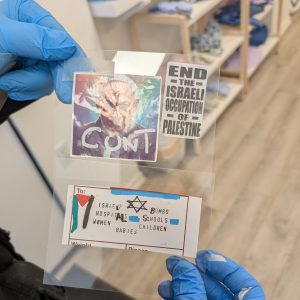A restored 300-year-old Torah scroll from Czechoslovakia that was transferred to its new home at Beth Emeth Bais Yehuda Synagogue in Toronto is being commemorated with a series of educational community activities.
On March 6, Songs of the Breathing Walls, a music and multimedia event featuring musicians Lenka Lichtenberg, David Buchbinder, Brian Katz and Lorie Wolf, will be held in recognition of the Jewish communities and synagogues of the Czech Republic.
“We know some facts about the Czech Torah, but not every detail,” said Eleanor Minuk, co-chair of the Czech Torah project. “It was separated from a cache of some 1,500 Torahs, which were hidden in Czechoslovakia from the Nazis. After the war was over, they were sent to London, England, to a memorial trust, before being sent out to different places and communities around the world.”
The Czech Torah was eventually bought by a private family. “Our Torah was split off from the collection before it was brought to England. A rabbi brought it to our attention,” said Allan Snow, president of Beth Emeth Bais Yehuda Synagogue. “The rabbi had obtained the Torah from a prominent family who had brought it to Canada, but was unable to repair it on their own.”
Beth Emeth received a donation to purchase the Torah from synagogue member Clement Cohen.
READ: FIFTEEN-YEAR-OLD SANG ON GRAMMY-NOMINATED ALBUM
According to the Czech Torah Network, the scroll comes from Czechoslovakia, where over 300,000 Jews lived prior to the Second World War. In 1942, members of the Jewish community brought a large collection of Judaica, which included over 1,500 Torah scrolls, to the Central Jewish Museum in Prague, from synagogues and communities in Bohemia and Moravia that were destroyed by the Nazis. They then sorted, classified and catalogued every artifact and arranged the Torah scrolls in stacks reaching from floor to ceiling. After the war, the Torah scrolls were transferred to a ruined synagogue.
In 1963, London art dealer Eric Estorick was approached by Artia – the Czech government department that controlled the sale of art – which offered him the opportunity to buy the scrolls. Estorick contacted one of his clients, Ralph Yablon, a prominent philanthropist and founding member of the Westminster Synagogue, who purchased all 1,564 scrolls and donated them to his synagogue.
Beth Emeth commissioned an expert who’s familiar with Torah repair to restore it, which took six and a half months. “Many hours were devoted to going through every single word and checking that each letter was kosher, and through the course of his work, we discovered there were many unique types of print,” said Minuk. “The way the letters were formed, the way there were crowns put over the letters … really unique features. We can’t determine exactly what the provenance is, although we can comment on how interesting they are.”
Significantly, it was found that the style used in the Torah predates the standardized style of writing. In fact, it predates the Keseth ha-Sofer, one of the earliest codifications of lettering. There are certain letters that do not align with any other script. During the restoration process, a series of short photo essays were produced, in order to showcase the process and the findings.
“Our Czech Torah is a survivor,” said Sheldon Zelsman, co-chair of the Czech Torah project. “From the original ktav, corrections, markings and even some wax drippings on the parchment, we learn a lot about what Jewish people did to ensure that it survived throughout its 300 years. What is most poignant is that we know that our Torah was purposefully stored away so that it would survive the Holocaust. But the most moving feeling for me throughout the restoration was being able to witness our Torah being brought back to life and being part of its continued survival and sharing its story to our community.”
The Torah is very delicate, but will be used for special occasions. “We have given voice back to our Czech Torah, because we have already read from it twice so far on Shabbat and will be using it again,” said Zelsman.
The sentiment surrounding the historic Torah is summarized by Minuk: “To be able to say that we now have a kosher Torah that is over 300 years old is remarkable.”
Register for Songs of the Breathing Walls at 416-633-3838.






